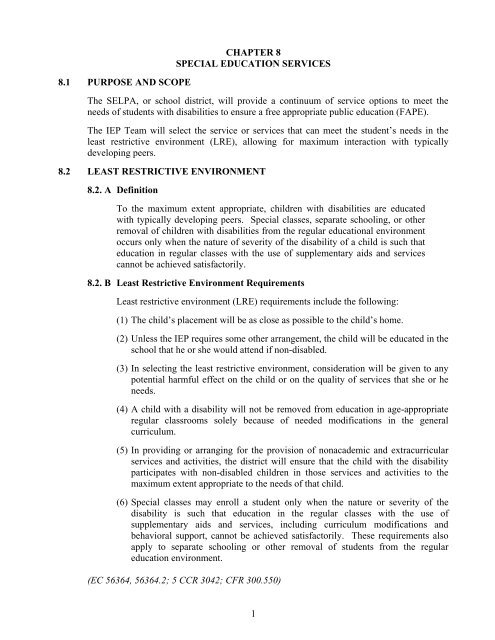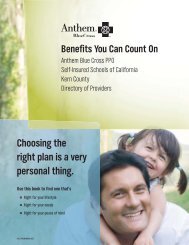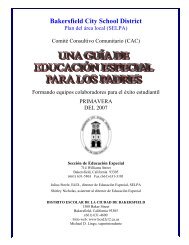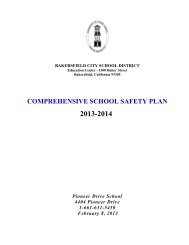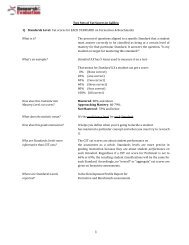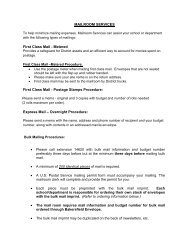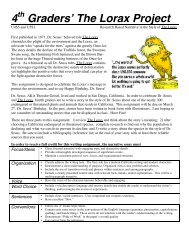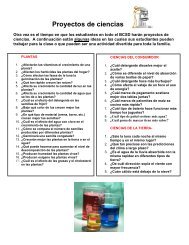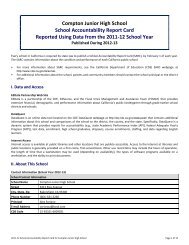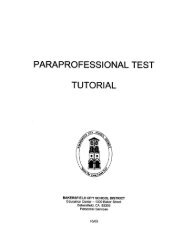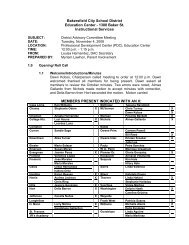CHAPTER 8 - BCSD Static Server - Bakersfield City School District
CHAPTER 8 - BCSD Static Server - Bakersfield City School District
CHAPTER 8 - BCSD Static Server - Bakersfield City School District
Create successful ePaper yourself
Turn your PDF publications into a flip-book with our unique Google optimized e-Paper software.
8.1 PURPOSE AND SCOPE<br />
<strong>CHAPTER</strong> 8<br />
SPECIAL EDUCATION SERVICES<br />
The SELPA, or school district, will provide a continuum of service options to meet the<br />
needs of students with disabilities to ensure a free appropriate public education (FAPE).<br />
The IEP Team will select the service or services that can meet the student’s needs in the<br />
least restrictive environment (LRE), allowing for maximum interaction with typically<br />
developing peers.<br />
8.2 LEAST RESTRICTIVE ENVIRONMENT<br />
8.2. A Definition<br />
To the maximum extent appropriate, children with disabilities are educated<br />
with typically developing peers. Special classes, separate schooling, or other<br />
removal of children with disabilities from the regular educational environment<br />
occurs only when the nature of severity of the disability of a child is such that<br />
education in regular classes with the use of supplementary aids and services<br />
cannot be achieved satisfactorily.<br />
8.2. B Least Restrictive Environment Requirements<br />
Least restrictive environment (LRE) requirements include the following:<br />
(1) The child’s placement will be as close as possible to the child’s home.<br />
(2) Unless the IEP requires some other arrangement, the child will be educated in the<br />
school that he or she would attend if non-disabled.<br />
(3) In selecting the least restrictive environment, consideration will be given to any<br />
potential harmful effect on the child or on the quality of services that she or he<br />
needs.<br />
(4) A child with a disability will not be removed from education in age-appropriate<br />
regular classrooms solely because of needed modifications in the general<br />
curriculum.<br />
(5) In providing or arranging for the provision of nonacademic and extracurricular<br />
services and activities, the district will ensure that the child with the disability<br />
participates with non-disabled children in those services and activities to the<br />
maximum extent appropriate to the needs of that child.<br />
(6) Special classes may enroll a student only when the nature or severity of the<br />
disability is such that education in the regular classes with the use of<br />
supplementary aids and services, including curriculum modifications and<br />
behavioral support, cannot be achieved satisfactorily. These requirements also<br />
apply to separate schooling or other removal of students from the regular<br />
education environment.<br />
(EC 56364, 56364.2; 5 CCR 3042; CFR 300.550)<br />
1
8.3 CONTINUUM OF SERVICE OPTIONS<br />
The continuum of options includes, but is not necessarily limited to, all of the following or<br />
any combination of the following:<br />
a) Regular education programs with specially designed modifications.<br />
b) Regular education classroom with resource specialist services.<br />
c) Regular education classroom with related services.<br />
d) Regular education classroom with services from a special day class teacher and supports<br />
and/or related services.<br />
8.3. A Special Classes and Centers<br />
Instruction in settings other than classrooms where specially designed instruction<br />
may occur.<br />
Itinerant instruction in classrooms, resource rooms, and settings other than<br />
classrooms where specially designed.<br />
Instruction using telecommunication and instruction in the home, in hospitals, and in<br />
other institutions.<br />
8.3. B Nonpublic, Nonsectarian <strong>School</strong> Services.<br />
“Nonpublic, nonsectarian school” means a private, nonsectarian school that enrolls<br />
individuals with exceptional needs pursuant to an individualized education program<br />
and is certified by the CDE.<br />
8.3. C State Special <strong>School</strong>s.<br />
In determining the educational placement of a child with a disability, including a<br />
preschool child, the district will ensure that the placement decision is made by a<br />
group of persons, including the parents, and other persons knowledgeable about the<br />
child, the meaning of the evaluation data, and the placement options.<br />
All placement decisions will be based on the individual need of the student pursuant<br />
to the IEP and not on the basis of the disability, configuration of service delivery,<br />
availability of staff, curriculum intent or administrative experience. All placements<br />
will be made in the least restrictive environment.<br />
(EC 56360, 56361; CFR 300.551, 300.26)<br />
8.3. D Related Services (EC 56363)<br />
Related services as specified in the IEP shall be available, when the instruction and<br />
services are necessary for the student to benefit educationally from his or her special<br />
2
education program. These services may include, but are not limited to, the<br />
following:<br />
Language and Speech Development and Remediation (CCR 3051.1)<br />
The related service in language speech and hearing may include:<br />
(1) Specialized instruction and services for students with disorders of language,<br />
speech and/or hearing, including monitoring of student progress on a regular<br />
basis, providing information for the review, and when necessary participating in<br />
the review and revision of IEPs of students.<br />
(2) Consultative services to students, parents, teachers, or other school personnel in<br />
the management of a student’s language, speech development, or hearing needs.<br />
(3) Coordination of speech and language services with a student’s regular and<br />
special education program.<br />
(4) The person providing instruction and services shall hold an appropriate credential<br />
with specialization in language, speech and hearing.<br />
Caseloads of full-time equivalent speech/language pathologist shall not exceed a<br />
district-wide or SELPA-wide average of (55) fifty-five students unless prior written<br />
approval has been granted by the State Superintendent of Public Instruction.<br />
Services may be provided by a speech/language pathology assistant working under<br />
the direct supervision of a credential speech/language pathologist if specified in the<br />
IEP.<br />
Audiological Services<br />
Audiological instruction and services, aural rehabilitation, including auditory<br />
training and speech reading, may include the following:<br />
(1) Aural rehabilitation (auditory training, speech reading, language habilitation and<br />
speech conservation) and habilitation with individual students or groups and<br />
support for the hearing-impaired students in the regular classroom.<br />
(2) Monitoring hearing levels, auditory behavior, and amplification for all students<br />
requiring personal or group amplification in the instructional setting.<br />
(3) Planning, designing, organizing and implementing an audiology program for<br />
individuals with auditory dysfunction, as specified in the IEP.<br />
(4) Consultative services regarding test findings, amplification needs and equipment,<br />
ontological referrals, home training programs, acoustic treatment of rooms, and<br />
educational management of the hearing-impaired individuals.<br />
(5) The person providing audiological services shall hold a valid credential with a<br />
specialization in clinical or rehabilitative services in audiology.<br />
Orientation and Mobility Instruction (CCR 3051.3)<br />
Related services in orientation and mobility may include the following:<br />
3
(1) Specialized instruction for individuals in orientation and mobility techniques.<br />
(2) Consultative services to other educators and parents regarding instructional<br />
planning and implementation of the IEP.<br />
(3) Counseling services to parents of individuals with disabilities relative to the<br />
development of orientation and mobility skills and independent living skills of<br />
their children.<br />
(4) The person providing mobility instruction and services shall hold a credential as<br />
an orientation and mobility specialist.<br />
Instruction in the Home and Hospital (CCR 3051.4)<br />
Related services in the home or hospital may include the following:<br />
(1) Instruction and services for individuals with disabilities whose physical condition<br />
requires their confinement for prolonged periods of time and who require longterm<br />
instruction at home or in a hospital. The IEP team must recommend this<br />
service.<br />
(2) Instruction and service for individuals with disabilities, whose disability restricts<br />
their capability to attend school, and whose instructional goals include both<br />
academic and rehabilitative services. This service must be recommended by the<br />
IEP tem and is regarded as an interim placement.<br />
(3) An individual with disabilities who is enrolled in home or hospital instruction<br />
shall receive 300 minutes per week of individual instruction or small group<br />
instruction of not more than four individuals, as specified in the IEP by the IEP<br />
team. Instruction of less than 300 minutes per week may be permitted if the IEP<br />
team feels that the individual’s health prevents a full 300 minutes.<br />
Instruction in the home or hospital shall be provided by a regular class teacher, the<br />
special class teacher or the resource specialist, if the teacher or specialist is<br />
competent to provide such instruction.<br />
Adapted Physical Education (APE) (CCR 3051.5)<br />
Adapted physical education is designed for students with disabilities who require<br />
developmental or corrective instruction and which preclude the individual’s<br />
participation in the activities of the general physical education program, modified<br />
regular physical education program, or in a specially designed physical education<br />
program in a special class.<br />
Consultative services may be provided to students, parents, teachers, or other school<br />
personnel for the purpose of identifying supplementary aids and services or<br />
modifications necessary for successful participation in the regular physical education<br />
program or specially designed physical education programs.<br />
4
Teachers instructing adapted physical education shall have a credential authorizing<br />
the teaching of adapted physical education as established by the Commission on<br />
Teacher Credentialing.<br />
Physical and Occupational Therapy (CCR 3051.6)<br />
When the district, SELPA or county office contracts for the services of a physical<br />
therapist or an occupational therapist, the following standards shall apply:<br />
(1) Occupational or physical therapists shall provide services based upon<br />
recommendation of the IEP Team. Physical therapy service may not exceed the<br />
services specified in the Business and Professions Code at Section 2620.<br />
(2) The district, SELPA, or county office shall assure that the therapist has available<br />
safe and appropriate equipment.<br />
(3) A physical therapist shall be currently licensed by the Board of Medical Quality<br />
Assurance of the State of California and meet the educational standards of the<br />
Physical Therapy Examining Committee.<br />
(4) An occupational therapist shall be currently registered with the American<br />
Occupational Therapy Association.<br />
Vision Services (CCR 3051.7)<br />
Related services for the students with visual disabilities may include the following:<br />
(1) Adaptations in curriculum, media, and the environment, as well as instruction in<br />
special skills.<br />
(2) Consultative services to students, parents, teachers, and other school personnel.<br />
(3) The person providing services shall hold an appropriate credential with<br />
specialization in the area of the visually impaired.<br />
Counseling and Guidance (CCR 3051.9)<br />
Counseling and guidance services may be provided to an individual with a disability<br />
that requires additional counseling and guidance services to supplement the regular<br />
guidance and counseling program. The IEP team shall determine the need for<br />
additional guidance and counseling services. Services may include:<br />
(1) Educational counseling in which the student is assisted in planning and<br />
implementing his or her immediate and long-range educational program.<br />
(2) Personal counseling in which the student is helped to develop his or her ability to<br />
function with social and personal responsibility.<br />
(3) Counseling and consultation with parents and staff members on learning<br />
problems and guidance programs for students.<br />
5
(4) The individual performing counseling services to students shall be qualified.<br />
Psychological Services (CCR 3051.10)<br />
Related psychological services other than assessment and development of the IEP<br />
may include:<br />
(1) Counseling provided to an individual with disabilities by a credentialed or<br />
licensed psychologist or other qualified personnel.<br />
(2) Consultative services to parents, students, teachers and other school personnel.<br />
(3) Planning, managing and implementing a program of psychological counseling<br />
for eligible children and parents as specified in the IEP.<br />
Parent Counseling and Training (CCR 3051.11)<br />
Parent counseling and training may include:<br />
(1) Assisting parents in understanding the special needs of their child, and<br />
(2) Providing parents with information about child development.<br />
Health and Nursing Services<br />
Related health and nursing services are designed to assist those individuals with<br />
disabilities who have health problems. Qualified personnel will provide services.<br />
Services may include the following:<br />
(1) Managing the individual’s health problems on the school site;<br />
(2) Consulting with staff members regarding management of the individual’s health<br />
problems;<br />
(3) Providing group and individual counseling with the individuals and parents<br />
regarding health problems; and<br />
(4) Making appropriate referrals and maintaining communication with health<br />
agencies providing care to individuals.<br />
Specialized Services for Low Incidence Disabilities<br />
Specialized services for low incidence disabilities may include:<br />
(1) Specially designed instruction related to the unique needs of students with lowincidence<br />
disabilities.<br />
(2) Specialized services related to the unique needs of students with low-incidence<br />
disabilities provided by qualified individuals such as interpreters, note-takers,<br />
readers, transcribers, and other individuals who provide specialized materials and<br />
equipment.<br />
(3) Services will be provided by appropriately credentialed teachers.<br />
6
Services for Students with Chronic Illnesses or Acute Health Problems (CCR<br />
3051.17)<br />
Specialized services for students with chronic illnesses or acute health problems<br />
include but are not limited to:<br />
(1) Individual consultation;<br />
(2) Home or hospital instruction; and<br />
(3) Other instructional methods using advanced communication technology.<br />
Services for Deaf and Hard of Hearing Students<br />
Related services for deaf and hard of hearing students may include but need not be<br />
limited to:<br />
(1) Speech, speech reading and auditory training;<br />
(2) Instruction in oral, sign, and written language development;<br />
(3) Rehabilitative and educational services for hearing impaired individuals to<br />
include monitoring amplification, coordinating information for the annual<br />
review, and recommending additional services;<br />
(4) Adapting curricula, methods, media, and the environment to facilitate the<br />
learning process; and<br />
(5) Consultation to students, parents, teachers, and other school personnel as<br />
necessary to maximize the student’s experience in the regular education program.<br />
A specially trained instructional aide, working with and under the direct supervision<br />
of the credentialed teacher of the deaf and hard-of-hearing, may assist in the<br />
implementation of the student’s educational program.<br />
Services will be provided by an individual holding an appropriate credential to<br />
provide services to the hearing impaired and who has training, experience and<br />
proficient communication skills for educating students with hearing impairments.<br />
Individual and Small Group Instruction<br />
Instruction delivered one-to-one or in a small group as specified in an IEP enabling<br />
the student(s) to participate effectively in the total school program.<br />
8.3. E Resource Specialist Program/Non-intensive Services Program Description<br />
(EC 56362)<br />
Program Description<br />
The resource specialist program/non-intensive services shall provide, but not be<br />
limited to, all of the following:<br />
(1) Provision for a resource specialist or specialists who shall provide instruction and<br />
services for those students whose needs have been identified in an IEP,<br />
developed by the IEP Team, and who are assigned to regular classroom teachers<br />
for a majority of a school day;<br />
7
(2) Provision of information and assistance to students with disabilities and their<br />
parent;<br />
(3) Provision of consultation, resource information, and material regarding students<br />
with disabilities to their parents and to regular staff members;<br />
(4) Coordination of special education services with the regular school programs for<br />
each student enrolled in the resource specialist program;<br />
(5) Monitoring of student progress on a regular basis, participation in the review and<br />
revision of individualized education programs, as appropriate, and referral of<br />
students who do not demonstrate appropriate progress to the IEP Team; and<br />
(6) Emphasis at the secondary school level on academic achievement, career and<br />
vocational development, and preparation for adult life.<br />
Program Staffing<br />
The resource specialist program/non-intensive program shall be under the direction of a<br />
resource specialist/mild to moderate specialist, who is a credentialed special education<br />
specialist, or who has a clinical services credential, with a special class authorization, who<br />
has had three or more years of teaching experience, including both regular and special<br />
education teaching experience, and who has demonstrated the competencies for a resource<br />
specialist, as established by the Commission on Teacher Credentialing.<br />
At least 80 percent of the resource specialists within a local plan shall be provided with an<br />
instructional aide.<br />
No resource specialist shall have a caseload that exceeds 28 students without a waiver.<br />
Resource specialists shall not simultaneously be assigned to serve as resource specialists and<br />
to teach regular classes.<br />
Provision for a resource specialist or specialists who shall provide instruction and services<br />
for those pupils whose needs have been identified in an individualized education program<br />
developed by the individualized education program team and who are assigned to regular<br />
classroom teachers for a majority of a school day.<br />
(EC 56362)<br />
8.3. F Special Education/Intensive Services<br />
Program Description<br />
Placement in a special day class/intensive services shall not limit or restrict the<br />
consideration of other options, including services provided in a vocational education<br />
program or any combination of programs and placements as may be required to<br />
provide the services specified in a student’s IEP.<br />
The following standards for special classes shall be met:<br />
(a) Special classes may enroll students only when the nature or severity of the<br />
disability of the student is such that education in the regular classes with the use<br />
of supplementary aids and services including curriculum modification and<br />
8
ehavioral support cannot be achieved satisfactorily. These requirements also<br />
apply to separate schooling or other removal of individuals with disabilities from<br />
the regular educational environment;<br />
(b) A special class shall be composed of students whose needs as specified in the<br />
IEPs can be appropriately met within the class;<br />
(c) Students in a special class shall be provided with an educational program in<br />
accordance with their individualized education programs for at least the same<br />
length of time as the regular school day for that chronological peer group;<br />
(d) When a student can benefit by attending a regular program for part of the day,<br />
the amount of time shall be written in the IEP;<br />
(e) Students with low incidence disabilities may receive all or a portion of their<br />
instruction in the regular classroom, while being enrolled in special classes<br />
taught by an appropriately credentialed teacher, who serves these students at one<br />
or more school sites, with instruction provided consistent with state guidelines;<br />
and<br />
(f) When the IEP team determines that a student cannot function for the period of<br />
time of a regular school day, and when it is so specified in the IEP, a student may<br />
be permitted to attend a special class for less time than the regular school day for<br />
that chronological peer group.<br />
Program Staffing<br />
The special class shall be taught by a teacher, whose responsibility is the instruction,<br />
supervision, and coordination of the educational program for those students enrolled<br />
in the special class.<br />
The special class teacher must hold an appropriate special education credential and<br />
possess the necessary competencies to teach students assigned to the class.<br />
The procedure for allocation of aides for special classes shall be specified in the local<br />
plan. Additional aide time may be provided when the severity of the handicapping<br />
conditions of the pupils or the age of the pupils justifies it, based on the<br />
individualized education programs.<br />
(5 CCR 3053)<br />
8.3. G Nonpublic, Nonsectarian <strong>School</strong>s and Agencies (EC 56365)<br />
When a student with disability’s educational needs cannot be met in a public<br />
educational program, nonpublic nonsectarian school services shall be made<br />
available.<br />
These services shall be provided under contract with the SELPA, or county office to<br />
provide the appropriate special educational facilities, special education, or related<br />
services required by the individual with disabilities, when no appropriate public<br />
education program is available.<br />
Refer to Chapter 11 for complete information about nonpublic nonsectarian schools<br />
and agencies.<br />
9
Initial Health History (form HS 9)<br />
Health History and Nursing Assessment for<br />
Special Education Process and Forms<br />
This form is to be utilized for all initial Search and Serve referrals, Speech only assessments,<br />
RSP initial assessments, and SDC initial assessments where no known health condition<br />
exists.<br />
The nurse is to review this form, sign, date and make pertinent comments such as “no<br />
indication of health concerns”. If there is an indication of health concerns then a more indepth<br />
assessment must be completed and follow-up documented.<br />
Health History Update (form HS 10)<br />
This form is to be utilized for all Speech only tri-annual, RSP tri-annual, and SDC triannuals<br />
where no known health conditions exists.<br />
The nurse is to review this form, sign, date and make pertinent comments such as “no<br />
indication of health concerns”. If there is an indication of health concerns or changes since<br />
previous health assessment then a more in-depth assessment must be completed and followup<br />
documented.<br />
Nursing Assessment (form NA-2)<br />
This form is to be utilized for those students for whom the need for a more in-depth nursing<br />
assessment is indicated on the health history form in the mild/moderate program and who<br />
have non-complex medical concerns. This form may also be utilized for tri-annual updated<br />
nursing assessments for all students.<br />
Nursing Assessment (form NA-1)<br />
This form is to be utilized for initial assessment on all students with a determination of<br />
severely handicapped or who have a complex medical condition. This form is also to be<br />
completed on all Early Start initial referrals in addition to the IFSP form.<br />
Nursing Summary (form NA-3)<br />
This form is to be utilized for those students who need updates do to changes in status prior<br />
to a three year re-assessment. It can also be utilized for tri-annual for all students with noncomplex<br />
medical concerns such as on-going treatment for head lice, asthma, etc.<br />
Health Summary (Form HS-82)<br />
This form can be utilized for those students who need updates due to changes in status prior<br />
to a three year re-assessment. It can also be utilized for tri-annual for all students with noncomplex<br />
medical concerns such as on going treatment for head lice, asthma, etc.<br />
10
BAKERSFIELD CITY SCHOOL DISTRICT<br />
HEALTH SERVICES – 714 Williams Street<br />
<strong>Bakersfield</strong>, CA 93305- (661) 631-5895<br />
Date<br />
<strong>School</strong><br />
Grade<br />
Teacher<br />
INITIAL HEALTH HISTORY<br />
SID #: Pupil’s Social Security #: - -<br />
Pupil’s Name Sex Birthdate Age<br />
Parents: Father In Home Yes No Mother In Home Yes No<br />
Address<br />
Guardian/Other<br />
Name of Person Completing Form<br />
Phone<br />
Relationship<br />
Relationship<br />
Physician Address Phone #<br />
Dentist Address Phone #<br />
Current Medication (Indicate name and how often given)<br />
Known Allergies<br />
Is child a Client of: MediCal SSI CCS KRC<br />
Vision Tested: Results Hearing Tested Results<br />
PLEASE CHECK THE APPROPRIATE ANSWER IN THE FOLLOWING SECTIONS AND EXPLAIN ‘YES’ ANSWER UNDER COMMENTS<br />
PREGNANCY HISTORY (With this child) Mother’s age Received Medical care Yes No<br />
(at time of pregnancy)<br />
Yes No Used tobacco – How much Yes No Infections<br />
Yes No Consumed alcohol – How much Yes No Previous miscarriage<br />
Yes No Medicines Yes No Maternal diabetes<br />
Yes No Used recreational drugs – How much Yes No Pregnancy planned<br />
Yes No Weight gain more than 30 lbs. Yes No Mother illness or injury while pregnant<br />
Yes No High blood pressure Yes No Child # 1 2 3 4 5 6 or<br />
Yes No Length of pregnancy Yes No Other conditions/Illness<br />
DELIVERY HISTORY (with this child)<br />
Yes No Water broke too early / Premature rupture of membranes Yes No Normal delivery<br />
Yes No Cord around baby’s neck Yes No Forceps<br />
Yes No Mother asleep / General anesthetic Yes No Did baby cry right away<br />
Yes No Cesarean section (circle: Planned / Unplanned) Yes No Did baby breathe right away<br />
Yes No Any observed skull damage at birth Yes No RH incompatibility<br />
Yes No Oxygen given Yes No Fetal distress<br />
NEWBORN HISTORY (first month of this child’s life)<br />
Birth weight<br />
Age of baby when he/she came home from hospital<br />
Yes No Baby had yellow jaundice Yes No Vomiting<br />
Yes No Blueness of skin Yes No Diarrhea<br />
Yes No Seizures (convulsions) Yes No Infections<br />
Yes No Sleep problems Yes No Feeding problems<br />
Yes No Other Illnesses Yes No Other problems<br />
ILLNESSES (Please give approximate age of illness or injury)<br />
Yes No Age Skin infection Yes No Age Diabetes with medication<br />
Yes No Age Unconscious more than 1 hour Yes No Age Anemia<br />
Yes No Age Hayfever / Allergies Yes No Age Tumor or growth<br />
Yes No Age Hospitalization for Yes No Age Accidental poisoning<br />
Yes No Age Asthma Yes No Age Other Illnesses<br />
HS 9 FF Rev 7-06<br />
11
CURRENT HEALTH HISTORY (Review of Systems)<br />
1 - SKIN 9 - NEUROLOGICAL<br />
Rashes Yes No Cerebral Palsy<br />
Yes No Acne Yes No Headaches<br />
2 - EYE & VISION Yes No Seizures or convulsions<br />
Yes No Vision problems Yes No Overactive<br />
Yes No Eye pain or redness Yes No Fevers over 102 degrees<br />
Yes No Wears glasses Yes No Retardation<br />
Yes No Eye Surgery for Yes No Head injury (unconsciousness)<br />
3 – EARS & HEARING Yes No Fatigue (often too tired)<br />
Yes No Hearing aids 10 – SKELETAL SYSTEM<br />
Yes No Hearing problems Yes No Pain in arms and legs<br />
Yes No Ear infections, drainage (more than 2 per year) Yes No Limping<br />
Yes No Fevers Yes No Broken bones (which)<br />
Yes No Ear tubes Yes No Joint swelling or pain<br />
4 – NOSE AND THROAT Yes No Congenital abnormality<br />
Yes No Bloody noses 11 – PSYCHO-SOCIAL<br />
Yes No Difficulty swallowing Yes No Temper tantrums<br />
Yes No Swollen glands Yes No Is too shy<br />
Yes No Hoarseness Yes No Gets into trouble<br />
Yes No Speech difficulty Yes No Behavior problem at home<br />
Yes No Bad teeth / Cavities Yes No Trouble making/keeping friends<br />
5 – RESPIRATORY Yes No Poor sleep<br />
Yes No Frequent colds/sore throats Yes No Behavior problem in school<br />
Yes No Cough Yes No Inability to sit still<br />
Yes No Wheeze 12 - Gross & Fine Motor<br />
Yes No Bronchitis Gross: Fine:<br />
Yes No Croup Yes No Use a pencil Yes No Run without limitation<br />
6 - CARDIOVASCULAR Yes No Button & Zip Yes No Walk without limitation<br />
Yes No Chest pain Yes No Tie Shoes If no, explain:<br />
Yes No Heart defects<br />
7 – GASTROINTESTINAL 13 - Nutrition<br />
Yes No Frequent vomiting Foods he/she likes;<br />
Yes No Weight loss<br />
Yes No Overweight Foods he/she dislikes:<br />
Yes No Poor growth<br />
Yes No Abdominal pain 14 - Self-Care<br />
Yes No Digestion difficulty Yes No Toilet self<br />
Yes No Blood in stool Yes No Bath self<br />
Yes No Constipation Yes No Feed self<br />
Yes No Diarrhea Yes No Dress self<br />
Yes No Soiled pants If No, explain:<br />
Yes No Ulcer<br />
Yes No Other bowel problems 15 - OTHER<br />
8 - GENITAL-URINARY Any known syndrome<br />
Yes No Pain upon urination Operations<br />
Yes No Frequent urination<br />
Yes No Frequent daytime accidents<br />
Yes No Bedwetting Other Health Problems<br />
Yes No Blood in urine<br />
COMMENTS<br />
WHEN DID YOUR CHILD FIRST DO EACH OF THE FOLLOWING<br />
Sit Alone Crawl Walk Talk Toilet Trained<br />
Reviewed by: R.N., <strong>School</strong> Nurse Date<br />
Nurse Comments:<br />
12
BAKERSFIELD CITY SCHOOL DISTRICT<br />
HEALTH SERVICES – 714 Williams Street<br />
<strong>Bakersfield</strong>, CA 93305- (661) 631-5895<br />
Date<br />
<strong>School</strong><br />
Grade<br />
Teacher<br />
HEALTH HISTORY UPDATE<br />
SID #: Pupil’s Social Security #: - -<br />
Pupil’s Name Sex Birthdate Age<br />
Parents: Father In Home Yes No Mother In Home Yes No<br />
Address<br />
Guardian/Other<br />
Name of Person Completing Form<br />
Phone<br />
Relationship<br />
Relationship<br />
Physician Address Phone #<br />
Current Medication (Indicate name and how often given)<br />
Known Allergies<br />
Is child a Client of: MediCal SSI CCS KRC<br />
Vision Tested: Results Hearing Tested Results<br />
CURRENT HEALTH HISTORY (Review of Systems) Please circle YES to any of the following that your child has had with in the last three (3) years<br />
ILLNESSES (Please give approximate age of illness or injury)<br />
Yes No Age:_ _ Skin infection Yes No Age:_ _ Diabetes with medication<br />
Yes No Age:_ _ Unconscious more than 1 hour Yes No Age:_ _ Anemia<br />
Yes No Age:_ _ Hay fever/Allergies Yes No Age:_ _ Tumor or growth<br />
Yes No Age:_ _ Hospitalization (reason) Date Yes No Age:_ _ Accidental poisoning<br />
Yes No Age:_ _ Asthma Yes No Age:_ _ Other illnesses<br />
Yes No Age:_ _ Frequent fevers<br />
1 - SKIN 7 – GASTROINTESTINAL (continued)<br />
Yes No Rashes / Sores Yes No Poor growth<br />
2 - EYE & VISION Yes No Abdominal pain<br />
Yes No Eye Surgery for Yes No Digestion difficulty<br />
Yes No Vision problems Yes No Bright red blood in stool<br />
Yes No Eye pain or redness Yes No Constipation<br />
Yes No Wears glasses Yes No Diarrhea<br />
Yes No Wears contacts Yes No Soiled pants<br />
3 – EARS & HEARING Yes No Ulcer<br />
Yes No Hearing aids Yes No Other bowel problems<br />
Yes No Hearing problems 8 - GENITAL-URINARY<br />
Yes No Ear infections, drainage (more than 2 per year) Yes No Pain upon urination<br />
Yes No Ear tubes Yes No Frequent urination<br />
4 – NOSE AND THROAT Yes No Frequent daytime accidents<br />
Yes No Bad teeth / Cavities Yes No Bedwetting<br />
Yes No Bloody noses Yes No Blood in urine<br />
Yes No Difficulty swallowing 9 - NEUROLOGICAL<br />
Yes No Swollen glands Yes No Headaches<br />
5 – RESPIRATORY Yes No Cerebral Palsy<br />
Yes No Frequent colds/sore throats Yes No Seizures or convulsions<br />
Yes No Cough Yes No Head injury (unconsciousness)<br />
Yes No Asthma/Current meds Yes No Fatigue (often too tired)<br />
6 - CARDIOVASCULAR 10 – SKELETAL SYSTEM<br />
Yes No High Blood pressure Yes No Pain in arms and legs<br />
Yes No Chest pain Yes No Limping<br />
Yes No Heart defects Yes No Broken bones (which)<br />
7 – GASTROINTESTINAL Yes No Joint swelling or pain<br />
Yes No Frequent vomiting Yes No Congenital abnormality<br />
Yes No Weight loss<br />
Yes No Overweight<br />
HS-10 FF 9-23-05 13
11 – PSYCHO-SOCIAL Other Health Problems<br />
Yes No Temper tantrums<br />
Yes No Is too shy<br />
Yes No Trouble making/keeping friends<br />
Yes No Poor sleep<br />
12 - OTHER COMMENTS<br />
Any known syndrome<br />
Operations<br />
I hereby give consent for a <strong>School</strong> Nurse or <strong>District</strong> Administrator to communicate with my child’s physician or licensed<br />
Health Care Provider, and school personnel as needed regarding the information contained on this form. I understand I have<br />
the right to rescind this consent at any time.<br />
Parent’s Signature<br />
Date<br />
Reviewed by: R.N., <strong>School</strong> Nurse Date<br />
COMMENTS:<br />
14


